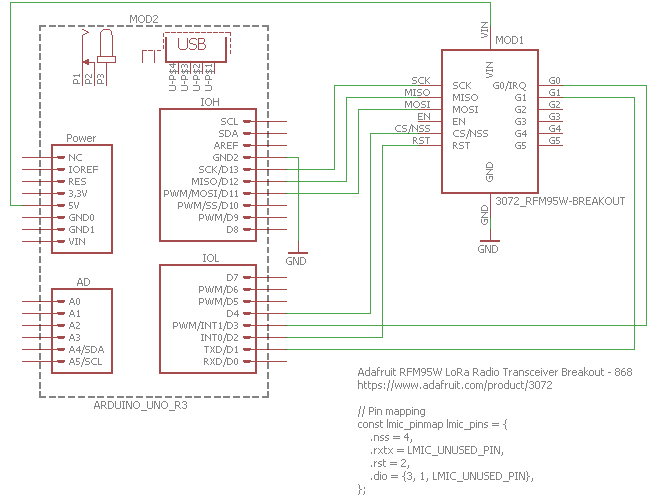Hi TTN community,
Please help with building and programming my first TTN node.
The hardware is:
- Arduino Uno R3
- Adafruit RFM95W LoRa Transceiver Breakout with 868 Mhz
The IDE is Arduino v1.8.9 with newest arduino-lmic-master library installed!
I used this tutorial:
https://www.mobilefish.com/developer/lorawan/lorawan_quickguide_build_lora_node_rfm95_arduino_uno.html
This is how the circuit looks like at the moment:

Pin mapping is in the schematics as well.
Node is registered with TTN and I tried the ttn-abp example in Debug Mode 2.
No error messages during compilation and upload.
This is what I always see in the terminal window:
08:07:58.915 -> Starting
08:07:58.962 -> RXMODE_RSSI
08:07:58.962 -> 78: irq: dio: 0x1 flags: 0x0
08:07:58.962 -> 114: Scheduled job 0x25d, cb 0 ASAP
08:07:58.962 -> 184: Cleared job 0x25d
08:07:58.962 -> 401: engineUpdate, opmode=0x808
08:07:58.962 -> 472: Uplink data pending
08:07:58.962 -> 605: Considering band 0, which is available at 398
08:07:59.009 -> 876: Considering band 3, which is available at 0
08:07:59.009 -> 1141: No channel found in band 3
08:07:59.009 -> 1311: Considering band 0, which is available at 398
08:07:59.009 -> 1594: No channel found in band 0
08:07:59.009 -> 1763: Considering band 1, which is available at 398
08:07:59.009 -> 2040: Airtime available at 398 (channel duty limit)
08:07:59.009 -> 2315: Ready for uplink
08:07:59.009 -> 2847: Updating info for TX at 471, airtime will be 3856. Setting available time for band 1 to 3826712576
08:07:59.009 -> 3099: TXMODE, freq=867300000, len=26, SF=7, BW=125, CR=4/5, IH=0
08:07:59.009 -> Packet queued
08:07:59.009 -> 3202: irq: dio: 0x1 flags: 0x0
08:07:59.056 -> 3371: Scheduled job 0x25d, cb 0xf11 ASAP
08:07:59.056 -> 3584: Running job 0x25d, cb 0xf11, deadline 0
08:07:59.056 -> 3830: Scheduled job 0x25d, cb 0xf24 at 62869
08:07:59.056 -> 4073: irq: dio: 0x1 flags: 0x0
08:07:59.056 -> 4235: Cleared job 0x25d
08:07:59.056 -> 4295: Scheduled job 0x25d, cb 0xf24 ASAP
08:07:59.056 -> 4513: Running job 0x25d, cb 0xf24, deadline 0
08:07:59.056 -> FAILURE
08:07:59.056 -> C:\Users\gknese\Documents\Arduino\libraries\arduino-lmic-master\src\lmic\radio.c:660
Please help
Kind regards
Gerd Knese
